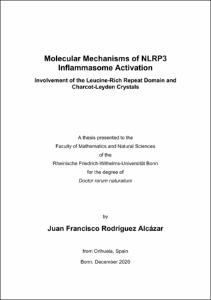Rodríguez Alcázar, Juan Francisco: Molecular Mechanisms of NLRP3 Inflammasome Activation : Involvement of the Leucine-Rich Repeat Domain and Charcot-Leyden Crystals. - Bonn, 2021. - Dissertation, Rheinische Friedrich-Wilhelms-Universität Bonn.
Online-Ausgabe in bonndoc: https://nbn-resolving.org/urn:nbn:de:hbz:5-63330
Online-Ausgabe in bonndoc: https://nbn-resolving.org/urn:nbn:de:hbz:5-63330
@phdthesis{handle:20.500.11811/9242,
urn: https://nbn-resolving.org/urn:nbn:de:hbz:5-63330,
author = {{Juan Francisco Rodríguez Alcázar}},
title = {Molecular Mechanisms of NLRP3 Inflammasome Activation : Involvement of the Leucine-Rich Repeat Domain and Charcot-Leyden Crystals},
school = {Rheinische Friedrich-Wilhelms-Universität Bonn},
year = 2021,
month = jul,
note = {Chronic inflammation is a major driver of several non-communicable diseases. The cytosolic pattern recognition receptor NLRP3 is involved in the development of many of these diseases, as its activation in innate immune cells promotes the assembly of a multi-molecular platform called the inflammasome. Inflammasome assembly results in two major pro-inflammatory outcomes: pyroptosis and the secretion of the cytokine interleukin-1beta. As excessive activation of the NLRP3 inflammasome can result in disease, its physiological regulation is critical. However, the molecular mechanisms that regulate and initiate NLRP3 activation are poorly characterized.
In this study, I propose that the leucine-rich repeat domain of NLRP3 plays an important role in its activation. Microscopy screening using solely the leucin-rich repeat domain of NLRP3 enabled me to define the residue F734 as an essential amino acid involved in the activation of NLRP3. Mechanistically, F734 is necessary for the processing of NLRP3 and its interaction with the inflammasome component NEK7. Additionally, I discovered that a defect in peroxisomal beta-oxidation exacerbates NLRP3 responses triggered by the endogenous activator extracellular ATP.
Furthermore, I report a previously uncharacterized activator of NLRP3, Charcot-Leyden crystals, which occur in tissues of patients with eosinophilic disorders. I show that Charcot-Leyden crystals are phagocytosed in vitro and in vivo by immune cells, and that this promotes inflammation by inducing interleukin-1beta release and neutrophil recruitment.
In all, my studies within this thesis describe a previously unknown relationship between peroxisomal function and NLRP3 activation, and pose proteolytic processing of the leucine-rich repeat domain of NLRP3 as a crucial event that mediates its activation. Furthermore, I propose NLRP3 as a potential drug target in eosinophilic disorders, where Charcot-Leyden crystals are present.},
url = {https://hdl.handle.net/20.500.11811/9242}
}
urn: https://nbn-resolving.org/urn:nbn:de:hbz:5-63330,
author = {{Juan Francisco Rodríguez Alcázar}},
title = {Molecular Mechanisms of NLRP3 Inflammasome Activation : Involvement of the Leucine-Rich Repeat Domain and Charcot-Leyden Crystals},
school = {Rheinische Friedrich-Wilhelms-Universität Bonn},
year = 2021,
month = jul,
note = {Chronic inflammation is a major driver of several non-communicable diseases. The cytosolic pattern recognition receptor NLRP3 is involved in the development of many of these diseases, as its activation in innate immune cells promotes the assembly of a multi-molecular platform called the inflammasome. Inflammasome assembly results in two major pro-inflammatory outcomes: pyroptosis and the secretion of the cytokine interleukin-1beta. As excessive activation of the NLRP3 inflammasome can result in disease, its physiological regulation is critical. However, the molecular mechanisms that regulate and initiate NLRP3 activation are poorly characterized.
In this study, I propose that the leucine-rich repeat domain of NLRP3 plays an important role in its activation. Microscopy screening using solely the leucin-rich repeat domain of NLRP3 enabled me to define the residue F734 as an essential amino acid involved in the activation of NLRP3. Mechanistically, F734 is necessary for the processing of NLRP3 and its interaction with the inflammasome component NEK7. Additionally, I discovered that a defect in peroxisomal beta-oxidation exacerbates NLRP3 responses triggered by the endogenous activator extracellular ATP.
Furthermore, I report a previously uncharacterized activator of NLRP3, Charcot-Leyden crystals, which occur in tissues of patients with eosinophilic disorders. I show that Charcot-Leyden crystals are phagocytosed in vitro and in vivo by immune cells, and that this promotes inflammation by inducing interleukin-1beta release and neutrophil recruitment.
In all, my studies within this thesis describe a previously unknown relationship between peroxisomal function and NLRP3 activation, and pose proteolytic processing of the leucine-rich repeat domain of NLRP3 as a crucial event that mediates its activation. Furthermore, I propose NLRP3 as a potential drug target in eosinophilic disorders, where Charcot-Leyden crystals are present.},
url = {https://hdl.handle.net/20.500.11811/9242}
}






